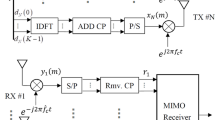Abstract
This paper investigated the channel estimation based inter-carrier interference (ICI) cancellation algorithm elimination of the orthogonal frequency division multiplexing (OFDM) system. Compared to the traditional technologies, this new algorithm would be processed as part of ICI as noise, and to reduce the effects of interference between the carrier frequency offset by simultaneous judgment and impulse channel frequency response (CFR). At the same time, the algorithm considered the CFR estimate of the frequency-offset effect, the closest to the actual frequency offset value, thereby reducing the ICI. To simplify the calculation, the frequency-offset hypothesis was determined utilizing a binary search method, and matrix interference was simplified. Simulation results demonstrated the effectiveness and superiority of the algorithm.









Similar content being viewed by others
References
Sun XD, Yu Q, Yuan HT (2003) Key technology of OFDM implementation [J]. Comput Electron 25(1):65–68
Armstrong J (1999) Analysis of new and existing methods of reducing intercarrier intercarrier interference due to carrier frequency offset in OFDM[J]. IEEE Trans Commun 47(3):365–369
Russell M, Stuber GL (1995) Interchannel interference analysis of OFDM in a mobileenvironment[J]. IEEE Vehic Techn Conf 15(2):820–824
Cheng LB (2008) An improved LMMSE channel estimation method and its performance analysis [J]. Acta Electron Sin 36(9):1782–1785
Krishnan KV, Sajith RM, Khara S (2015) Dynamic resource allocation in OFDM based cognitive radio system considering primary user QoS and secondary user proportional constraints [J]. J Commun Technol Electron 60(11):1269–1275
Azhar AH, Tran T, O’Brien D (2013) A gigabit/s indoor wireless transmission using MIMO-OFDM visible-light communications [J]. IEEE Photon Soc 25(2):171–174
Li Y, Stuber G (2006) Orthogonal frequency division multi –plexing for wireless communications [M]. Springer Press, New York
Ingle, VK, Proakis, JG. (2016) Digital signal processing using MATLAB [M]. Cengage Learning
Gupta V, Mohapatra D, Raghunathan A, Roy K (2013) Low-power digital signal processing using approximate adders [J]. IEEE Counc Electron Des Autom 32(1):124–137
Rabiner, LR, Gold, B. (1975) Theory and application of digital signal processing [M].Englewood Cliffs
Ahmed, N, Rao, KR. (2012) Orthogonal transforms for digital signal processing [M]. Springer Science & Business Media
Rabha WI (2015) Upper bound of partial sums determined by matrix theory [J]. Turkish J Anal Number Theory 3(6):149–153
Xu Z, Hu C, Mei L (2016) Video structured description technology based intelligence analysis of surveillance videos for public security applications. Multimedia Tools Appl 75(19):12155–12172
Xu Z, Mei L, Hu C, Liu Y (2016) The big data analytics and applications of the surveillance system using video structured description technology. Clust Comput 19(3):1283–1292
Xu Z, Wei X, Liu Y, Mei L, Hu C, Choo KR, Zhu Y, Sugumaran V (2016) Building the search pattern of web users using conceptual semantic space model. Int J Web Grid Serv (IJWGS) 12(3):328–347
Zhou Q (2016) Research on heterogeneous data integration model of group enterprise based on cluster computing. Clust Comput 19(3):1275–1282
Xu Z, Zhang H, Hu C, Mei L, Xuan J, Choo KR, Sugumaran V, Zhu Y (2016) Building knowledge base of urban emergency events based on crowdsourcing of social media. Concurr Comput: Pract Experience 28(15):4038–4052
Xu Z, Zhang H, Sugumaran V, Choo KR, Mei L, Zhu Y (2016) Participatory sensing-based semantic and spatial analysis of urban emergency events using mobile social media. EURASIP J Wireless Comm Netw 2016:44
Zhou Q, Luo J (2015) Artificial neural network based grid computing of E-government scheduling for emergency management. Comput Syst Sci Eng 30(5):327–335
Nakamura J (2016) Image sensors and signal processing for digital still cameras [M]. CRC press
Xi XP, Zhang C (2009) Study on ICI cancellation algorithms for mobile OFDM systems [J]. J Electron Inf Technol 31(3):25–28
Shen J (2006) On inter-cell interference mitigation for OFDM systems [J]. Telecommun Sci 7(1):10–13
Acknowledgements
This work was supported in part by Jiangsu Policy Guidance (Industry University Research) Project (Grant no. BY2016030-16), Major horizontal project (Grant no. KYH15052), Talent Introduction Project (Grant no. KYY15016) and Jiangsu Planned Projects for Postdoctoral Research Funds (Grant no. 1601138B).
Author information
Authors and Affiliations
Corresponding author
Rights and permissions
About this article
Cite this article
Liu, R., Zheng, E. Research on the Intelligent Signal Channel Sensing Based ICI Elimination Algorithm of the OFDM System. Mobile Netw Appl 22, 255–266 (2017). https://doi.org/10.1007/s11036-016-0792-7
Published:
Issue Date:
DOI: https://doi.org/10.1007/s11036-016-0792-7




